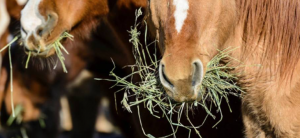 If your horse needs a low-carbohydrate diet, you can reduce the sugar concentration by soaking hay in water prior to feeding. While this has nearly become common knowledge, there is a lot of confusion about the best procedure to follow. How long do you soak the hay? In hot water or cold? By the half-bale or the fluffed-up flake? How much sugar is actually lost? And do all types of hay respond the same way to soaking? A study in England revealed some answers.
If your horse needs a low-carbohydrate diet, you can reduce the sugar concentration by soaking hay in water prior to feeding. While this has nearly become common knowledge, there is a lot of confusion about the best procedure to follow. How long do you soak the hay? In hot water or cold? By the half-bale or the fluffed-up flake? How much sugar is actually lost? And do all types of hay respond the same way to soaking? A study in England revealed some answers.
Nine types of hay were used in the study. Widely varying results were found between the types. Water-soluble carbohydrates (WSC) including fructans, glucose, fructose, and sucrose can be dissolved by soaking in either hot or cold water, though they dissolve more quickly in hot water. This study used cold water for periods of 20 minutes, 40 minutes, three hours, or 16 hours. The briefest soaking removed an average of about 5% of WSC, while the longest soaking removed 27%. Using compressed flakes or shaken-out loose hay made no significant difference. Finally, regardless of soaking time, there was no correlation between the original WSC content in a particular hay and the percentage of reduction after soaking.
Soaking removes some protein as well as carbohydrate. However, most hays don’t contain a high level of protein. This may not be very important to the horse’s total protein consumption. In this study, loss of protein was not significant regardless of the length of time hay was soaked.
So, what’s the scoop on soaking hay? If your horse has a metabolic condition that puts him at risk for laminitis if he consumes too much carbohydrate, the best practice is to buy the lowest-carbohydrate hay you can find. Soak it as long as possible or practical to remove some carbohydrates. It’s hard to know the WSC level of a particular cutting short of having each batch of hay analyzed for sugar content. Analyzing would be an expensive proposition. In general, more mature grass hays will have lower levels of sugar than legume hays or hays made from less mature grass. There is considerable variation among cuttings due to forage species, season, and other factors.
